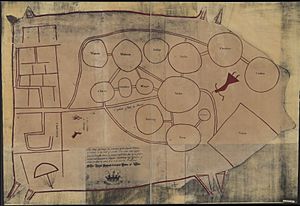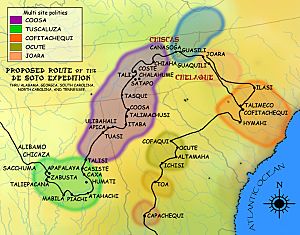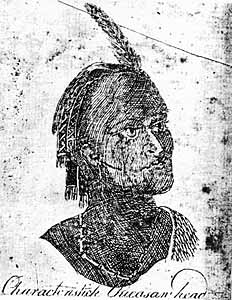Chickasaw facts for kids
| Chickasaw: Chikashsha | |
|---|---|
 |
|
| Total population | |
| 60,000 | |
| Regions with significant populations | |
| Languages | |
| English, Chickasaw | |
| Religion | |
| Traditional tribal religion, Christianity (Protestantism) | |
| Related ethnic groups | |
| Choctaw, Chakchiuma, Alabama, Koasati, Muskogee, and Seminole peoples |
The Chickasaw ( chik-Ə-saw) are a group of Indigenous people of the Southeastern Woodlands, United States. Their original homeland was in northern Mississippi, northwestern and northern Alabama, western Tennessee, and southwestern Kentucky. Their language is part of the Muskogean language family. Today, they are known as the federally recognized Chickasaw Nation.
The Chickasaw people have a story that says they moved from west of the Mississippi River. They traveled to what is now northeast Mississippi, northwest Alabama, and into Lawrence County, Tennessee. They met French, English, and Spanish colonists during the colonial period. The United States saw the Chickasaw as one of the Five Civilized Tribes of the Southeast. This was because they adopted many ways of life from European Americans. Even though they resisted settlers moving onto their land, the U.S. government forced them to sell their traditional lands. This happened with the 1832 Treaty of Pontotoc Creek. They had to move to Indian Territory (Oklahoma) during the Indian removal time in the 1830s.
Most of their descendants still live in what is now Oklahoma. The Chickasaw Nation in Oklahoma is the 13th-largest federally recognized tribe in the United States. Its members are related to the Choctaw and share a common history with them. The Chickasaw were divided into two main groups called moieties. These were the Imosak Cha'a' (chopped hickory) and the Inchokka' Lhipa' (worn out house). They traditionally followed a matrilineal descent system. This means that family lines and inheritance were traced through the mother. Children were considered part of their mother's family and clan. They also got their social status from her. Women often controlled property, and leadership in the tribe passed through the mother's side of the family.
Contents
What Does the Name Chickasaw Mean?
The name Chickasaw comes from a Chickasaw leader, according to anthropologist John Swanton. "Chickasaw" is the English way to spell Chikashsha. This means "comes from Chicsa." In 1890, R.W. McAdam wrote that "Chikasha" meant "rebel" in the Choctaw language. The Spanish explorer Hernando de Soto wrote about the people as Chicaza in 1540. His group was the first known Europeans to explore the North American Southeast.
The word -mingo (Chickasaw: minko) is used to mean a chief. For example, Tishomingo was a famous Chickasaw chief. The towns of Tishomingo in Mississippi and Oklahoma were named after him. Also, Tishomingo County in Mississippi was named for him.
A Look at Chickasaw History
The exact origin of the Chickasaw people is not fully known. Some scholars think the Chickasaw and Choctaw became separate groups in the 1600s. They may have come from older cultures like the Plaquemine culture. These groups had lived in the lower Mississippi Valley for thousands of years. When Europeans first met them, the Chickasaw lived in villages in what is now northeastern Mississippi.
The Chickasaw believe they moved into Mississippi from the west. Their oral history tells this story. They and the Choctaw were once one people. They migrated from west of the Mississippi River a long time ago. The Chickasaw and Choctaw separated during this journey. The Mississippian cultures built large, complex villages. These villages supported a society with different social levels. They were found throughout the Mississippi and Ohio River Valleys.
In the 1400s, early Chickasaw people left the Tombigbee Valley. This happened after the Moundville chiefdom fell apart. Chickasaw culture believes that the Mississippi River helped form the Chickasaw people. The Mississippi River is called Sakti Lhafa’ Okhina in Chikashanompa. This means “scored bluff waterway." Today, it is known as the Chickasaw Bluffs. Settling by the river gave the people a feeling of new beginnings. It was like washing away the past and starting a new age for the Chickasaw. This move also marked their split from other Native American groups like the Choctaws. They settled in the upper Yazoo and Pearl River valleys in Mississippi.
The Choctaws told a story that they came "out of a hole in the ground." This hole was between their land and the Chickasaws'. Another Chickasaw creation story says they came from Nanih Waiya. This is a large earthwork mound built around 300 CE. It is also a sacred place for the Choctaw, who have a similar story.
First Contact with Europeans
The first time Europeans met the Chickasaw was in 1540. The Spanish explorer Hernando de Soto found the tribe and stayed in one of their towns. This was likely near present-day Starkville, Mississippi. The Chickasaw were careful around the Spanish. They put up war banners to show their intentions. The Chickasaw also learned that the Spanish had recently fought a tough battle in Mabila. This was led by Chief Tascalusa, just months before the Spanish entered Chickasaw land.
In the winter of 1540, fighting broke out between Chickasaw warriors and the Spanish. The reasons for the battle vary. Some say the Spanish stole Chickasaw food. Others say there was general bad feeling between the groups. After many disagreements, the Chickasaw attacked De Soto's group in a night raid. They almost destroyed the Spanish force. The Spanish quickly moved on.
Trade and Alliances
The Chickasaw started trading with English colonists from the Province of Carolina. This began after Carolina was founded in 1670. The Chickasaw got firearms from English traders. They then started attacking settlements of a rival tribe, the Choctaw. They did this to capture people to sell to the colonists. These raids mostly stopped after the Choctaw got their own firearms from the French.
The Chickasaw were allies with British colonists in the Southern Colonies. They were often at war with the French and the Choctaw in the 1700s. An example is the Battle of Ackia on May 26, 1736. Small fights continued until France gave up its claims to the land east of the Mississippi River. This happened after the British defeated them in the Seven Years' War (called the French and Indian War in North America).
After the American Revolutionary War, in 1793–94, the Chickasaw fought with the new United States. They were allies under General Anthony Wayne against other Native American groups. The Shawnee and other allied tribes were defeated in the Battle of Fallen Timbers on August 20, 1794.
Historian Horatio Cushman wrote that the Choctaws and Chickasaws "never engaged in war against the American people." He said they "always stood as their faithful allies."
Trade Power of the Chickasaw
Even though they were smaller than many tribes around them, the Chickasaw became a strong trading power. Their location on the Mississippi River helped them trade goods with nearby groups. The British knew how important the Chickasaw's location was. In 1755, Edmund Atkin, a British official, said it was clear how important the Chickasaws' position was just by looking at a map.
The Chickasaw first officially met the British shortly after Charles Town was founded in 1670. This happened when Dr. Woordward of Carolina tried to start trade ties. The British outpost of Charles Town was over 850 kilometers from Chickasaw land. But the two groups still managed to trade deerskin. Soon after meeting the British, the Chickasaw also started trading with the French.
Within Chickasaw society, trade was split into two types: white (peace) routes and red (war) routes. A War Chief and a Peace Chief oversaw these two divisions. Over time, the French relationship was handled by the leaders of the white division. The English relationship was handled by the red division. Even though the French were closer to Chickasaw land, the tribe chose to focus on their trade routes with the British. The alliance between the British and the Chickasaw was a way to defend against the French and their Native American allies. The Chickasaw traded captured members of rival tribes for weapons. Since they were smaller than the Choctaw and other nearby groups, these weapons were very important for defending their homeland.
Chickasaw Lands and U.S. Relations
In 1797, Abraham Bishop described the Chickasaw and their land. He wrote that they lived on the east side of the Mississippi River. Their land was a large plain with good water and soil. They had seven towns and about 575 fighting men.
Working with the United States
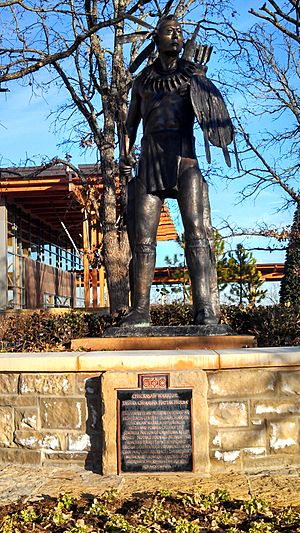
George Washington (the first U.S. President) and Henry Knox (the first U.S. Secretary of War) wanted Native Americans to change their way of life. Washington believed Native Americans were equal, but thought their society was not as good. He made a plan to encourage them to become more "civilized." Thomas Jefferson continued this plan. Historian Robert Remini wrote that they thought if Native Americans owned private property, built homes, farmed, educated their children, and became Christians, white Americans would accept them.
The U.S. government appointed Indian agents, like Benjamin Hawkins. These agents lived among the Native Americans to teach them how to live like white settlers. In the 1800s, the Chickasaw started to adopt many European-American ways. They built schools, farmed like settlers, became Christians, and built homes similar to their neighbors.
Because settlers were moving into Chickasaw land, the United States built Fort Hampton in 1810. This fort was meant to keep settlers out of Chickasaw territory. It was one of the few forts built to protect Native American land claims.
Treaties with the U.S.
The Chickasaw signed the Treaty of Hopewell in 1786. This treaty said that peace and friendship would last forever between the U.S. and the Chickasaw Nation.
In 1818, Chickasaw leaders signed several treaties. One was the Treaty of Tuscaloosa. This treaty gave up all their land claims north of Tennessee's southern border, up to the Ohio River. This area was called the "Jackson Purchase." The Chickasaw were allowed to keep a four-square-mile reservation. However, they had to lease this land to European immigrants.
The Colbert Family's Role
In the mid-1700s, James Logan Colbert, a trader of Scottish and Chickasaw background, settled in Alabama. He lived there for 40 years and married three important Chickasaw women. These marriages helped the tribe with trade. Colbert and his wives had many children, including seven sons. Six of them grew up to be important leaders.
The Chickasaw had a matrilineal system. This meant children were part of their mother's clan. They got their status from her family. Property and leadership passed through the mother's side. The mother's oldest brother was a main male guide for the children, especially boys. Because of their mothers' high status, the Colbert-Chickasaw sons and their children provided important leadership for nearly a century. They were also able to speak both English and Chickasaw.
William "Chooshemataha" Colbert fought with General Andrew Jackson in the Creek Wars (1813–14). His brothers Levi and George Colbert also served the United States in the military. They also worked as interpreters and negotiators for the tribe during the time of removal. Levi Colbert was a principal chief. After Levi died in 1834, the Chickasaw people were forced onto the Trail of Tears. His brother, George Colbert, became chief and negotiator. He died on Choctaw land before reaching the new Chickasaw territory.
Forced Removal (1832-1837)
In 1832, the state of Mississippi said it had power over the Chickasaw Indians. This made tribal self-governance illegal. So, Chickasaw chiefs met on October 20, 1832. They signed the Treaty of Pontotoc Creek. This treaty gave their remaining Mississippi land to the U.S. They agreed to find new land and move west of the Mississippi River. Between 1832 and 1837, the Chickasaw made more plans for their removal.
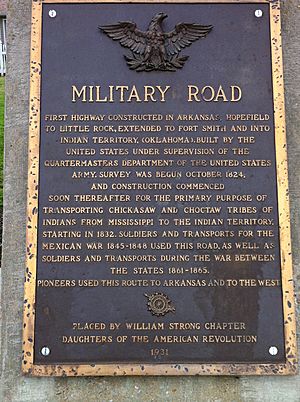
Unlike other tribes, the Chickasaw asked for money for their land. They were to receive $3 million from the United States for their lands east of the Mississippi River. In 1836, after five years of debate, the Chickasaw agreed to buy land in Indian Territory from the Choctaw. They paid the Choctaw $530,000 for the western part of their land. The first group of Chickasaw moved in 1837.
The Chickasaw gathered in Memphis, Tennessee, on July 4, 1837. They brought all their belongings, livestock, and enslaved African Americans. Three thousand and one Chickasaw people crossed the Mississippi River. They followed paths used by the Choctaw and Creek. During this journey, often called the Trail of Tears, more than 500 Chickasaw died from diseases like dysentery and smallpox.

When the Chickasaw reached Indian Territory, the U.S. government managed them through the Choctaw Nation. Later, they were combined for administrative reasons. The Chickasaw wrote their own constitution in the 1850s. Holmes Colbert helped with this. After many years of distrust, the Chickasaw re-established their own independent government in the 1900s. They are now federally recognized as the Chickasaw Nation. Their government is in Ada, Oklahoma.
The American Civil War (1861)
The Chickasaw Nation was the first of the Five Civilized Tribes to become allies of the Confederate States of America. They were still angry at the United States government. The U.S. had forced them off their lands and did not protect them from other tribes in the West. In 1861, as tensions grew, the U.S. Army left Fort Washita. This left the Chickasaw Nation without defense. Confederate officials tried to get Native American tribes to join them. They suggested an Indian state if the Confederacy won the Civil War.
The Chickasaw passed a resolution to ally with the Confederacy. Governor Cyrus Harris signed it on May 25, 1861.
Our protection was with the United States troops at Fort Washita. But they left us as soon as Confederate troops entered our country. To escape faster, they hired Black Beaver, a Shawnee Indian, for five thousand dollars. He guided them safely out of the Indian country. By this act, the United States abandoned the Choctaws and Chickasaws. . .
Then, with no other choice to save their country and property, they joined the Southern Confederacy.—Julius Folsom, September 5, 1891, letter to H. B. Cushman
At the start of the American Civil War, Albert Pike was sent by the Confederacy to Native Americans. He made several treaties, including the Treaty with Choctaws and Chickasaws in July 1861. This treaty had 64 terms. It covered topics like Choctaw and Chickasaw nation sovereignty and the chance for Confederate States of America citizenship. It also offered a delegate in the Confederate House of Representatives. Because the Chickasaw sided with the Confederacy, they had to give up some of their land afterward. The U.S. also changed their treaty. They insisted the Chickasaw free their slaves and offer citizenship to those who wanted to stay in the Chickasaw Nation. If they returned to the United States, they would have U.S. citizenship.
This was the first time in history the Chickasaws have ever made war against an English speaking people.
—Governor Cyrus Harris, As Chickasaw troops marched against the Union, 1860s.
After the Civil War
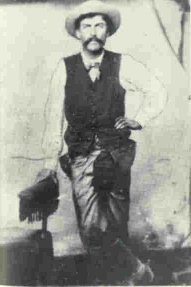
Because the Chickasaw allied with the Confederacy, the U.S. government required a new peace treaty in 1866. This treaty said they must emancipate the enslaved African Americans. It also said they must give full citizenship to those who wanted to stay in the Chickasaw Nation. These people and their descendants are known as the Chickasaw Freedmen. Their descendants still live in Oklahoma today.
However, the Chickasaw Nation never gave citizenship to the Chickasaw Freedmen. The only way African Americans could become citizens then was to have one or more Chickasaw parents. Or, they could ask for citizenship like other non-Natives. Because the Chickasaw Nation did not give citizenship to their Freedmen after the Civil War, the U.S. Government punished them. It took more than half of their land without paying them. They lost land that had been given to them in treaties after their removal from the Southeast.
Chickasaw Culture
For many tribes in the region, corn was a very important food. The Green Corn Ceremony happens every year when corn crops start to grow, usually in late June or early July. This ceremony connects corn to Chickasaw culture. It celebrates both the crop and the community. It was also a time for new beginnings. Villages were cleaned, old pottery was broken, and most old fires were put out. Many tribes fasted to become pure. The Chickasaw would fast from the first afternoon of the ceremony until the second sunrise.
In 2010, the tribe opened the Chickasaw Cultural Center in Sulphur, Oklahoma. It has the Chikasha Inchokka’ Traditional Village, Honor Garden, Sky and Water pavilion. It also has many exhibits about the Chickasaw culture. The Traditional Village has a Council House, two winter and summer houses, a replica mound, a corn crib, and a stickball field. There are often stomp dances or stickball demonstrations. Cultural performers show traditional Chickasaw art, cooking, language, and storytelling.
For the Chickasaw, the Mississippi River helped "define their geographic homeland and history." It was important for trade, transportation, and irrigation. Chickasaw warriors limited the movement of Europeans along the river.
Marriage Traditions
Before marriage, a Chickasaw man would send a gift with his mother or sister. This gift was for the parents of the woman he wanted to marry. If the parents agreed, they would offer the gift to the woman. If she accepted, the man's family member would return with the good news. The man would put on his best clothes and use vermilion paint. This paint was linked to love, power, and purity. The man would go to the woman's house. He would have supper alone with his future father-in-law. The wife or mother-in-law would not be there. The wife's bed would be ready, and the bride would go to sleep before the groom joined her. Once they were both in the same bed, they were officially married.
Beliefs and Religion
The Chickasaw people had old beliefs about four "Beloved Things": the sun, the clouds, the sky, and Aba' Binni'li. Aba' Binni'li was also known as "He that lives in the clear sky." He was believed to be the only creator of light, life, and warmth. He was thought to live in both the clouds and the holy fire. Because of this, fire was respected. It became against the rules to put out any fire, even a small cooking fire, with water. This was seen as the work of evil spirits. Bad weather like rain, thunder, and strong wind was thought to be holy people fighting above the clouds. Warriors would fire their guns at the sky. This showed they were willing to die if they could help the holy spirits above.
Returning Ancestors
After signing the Treaty of Pontotoc Creek in 1832, the Chickasaw tribe was forced from their homeland in Mississippi. They moved to what is now Oklahoma. While their current home is far from their original territory, the remains of many Chickasaw ancestors are still in Mississippi, Tennessee, and Alabama. Many of these remains were dug up and stored at the Mississippi Department of Archives and History (MDAH). In 2021, the MDAH returned 403 Chickasaw ancestors to the tribe. The director of archaeology for MDAH, Meg Cook, said they are doing everything they can to make up for the past and move forward.
Notable Chickasaw People
- Bill Anoatubby, Governor of the Chickasaw Nation since 1987
- Kaylea Arnett, professional sporting diver
- Jack Brisco and Jerry Brisco, pro wrestling tag team
- Jodi Byrd, Literary and political theorist
- Edwin Carewe (1883–1940), movie actor and director
- Charles David Carter, Democratic U. S. Congressman from Oklahoma
- Levi Colbert, Chickasaw language translator
- Tom Cole, Republican U.S. Congressman from Oklahoma
- Molly Culver, actress
- Kent DuChaine, American blues singer and guitarist
- Hiawatha Estes, architect
- Bee Ho Gray, actor
- John Herrington, astronaut; first Native American in space
- Linda Hogan, Writer-in-Residence of the Chickasaw Nation
- Miko Hughes, actor
- Sippia Paul Hull, early settler of Pauls Valley, Oklahoma
- Kyle Keller, Head Men's Basketball Coach, Stephen F. Austin Lumberjacks
- Neal A. McCaleb, Assistant U.S. Secretary for Indian Affairs (overseeing the BIA) under George W. Bush
- Wahoo McDaniel, pro wrestler, American Football League player
- Leona Mitchell, opera singer
- Rodd Redwing, actor
- Rebecca Sandefur, Sociologist and MacArthur Fellow
- Jerod Impichchaachaaha' Tate, composer and pianist
- Te Ata, traditional Indian storyteller and actress
- Fred Waite, cowboy and Chickasaw Nation statesman
- Kevin K. Washburn, Assistant U.S. Secretary for Indian Affairs under Barack Obama
- Montford Johnson, famous cattle rancher. In April 2020, Montford was inducted into the Hall of Great Westerners of the National Cowboy & Western Heritage Museum.
- Stephanie Byers, Kansas State Legislator. In November of 2020, Stephanie Byers, a retired music educator, became the first transgender Native American elected to a state legislature anywhere in the United States.
Chickasaw Population Changes
Chickasaw traditions say they once had 10,000 men ready for war. In 1687, Louis Hennepin estimated there were at least 4,000 Chickasaw warriors, meaning at least 20,000 people. In 1702, Iberville said there were about 2,000 Chickasaw families. Their numbers then dropped a lot during the 1700s and early 1800s, partly due to the Trail of Tears. In 1836, a report said there were about 5,400 Chickasaw people. Another source said the population before removal was 4,914 Chickasaws and 1,156 enslaved Black people. A report from 1841 said about 4,600 Chickasaws already lived in Oklahoma, while about 400 stayed in the east. In 1875, the Office of Indian Affairs reported around 6,000 Chickasaws. This number was reported until 1897. In 1910, a report said there were 5,688 Chickasaws by blood, 645 by marriage, and 4,651 freedmen. The 1910 census counted only 4,204 Chickasaws.
The Chickasaw population has grown back in the 1900s and 2000s. In 2020, they numbered 70,096, with 32,579 living in Oklahoma.
Images for kids
See also
 In Spanish: Chickasaw para niños
In Spanish: Chickasaw para niños


